
Mantica
The Infant Sea
Born of the melting ice at the end of the Winter War, the Infant Sea rushed in to drown the lands of men with terrifying rapidity. Once, the basin now occupied by that engulfing ocean was a fertile place, good cropland with many freshwater lakes at its centre. The bulk of the Republic of Primovantor, as well as many other kingdoms, was drowned under the Infant Sea’s waters, only the northernmost regions and the mountainous province of Basilea surviving. A few islands are all that remain of once-mighty mountains, their peaks providing isolated pockets of land. Weather-worn statues and crumbled temples are all that remain of the people that once lived there. The Infant Sea is home to strange creatures, submarine races and terrible monsters. Trade routes crisscross the sea, linking together the cities and lands that surround it, but to sail these waters is not something to be done lightly.
The Civilised Lands
Much of the Infant Sea is surrounded by a jagged coastline of vast mountain ranges, the tallest and most famed of which is the Dragon’s Teeth, which bound the entire north of the sea. In the foothills of the Dragon’s Teeth, and along the narrow coastal plains at their feet, are to be found the majority of the realms of civilised Men. No longer governed by a Grand Republic, these realms, kingdoms, city-states, baronies and clans rise and fall on a daily basis, with new territory carved in battle, tenuous alliances forged, and entire cities wiped from the map by marauders.
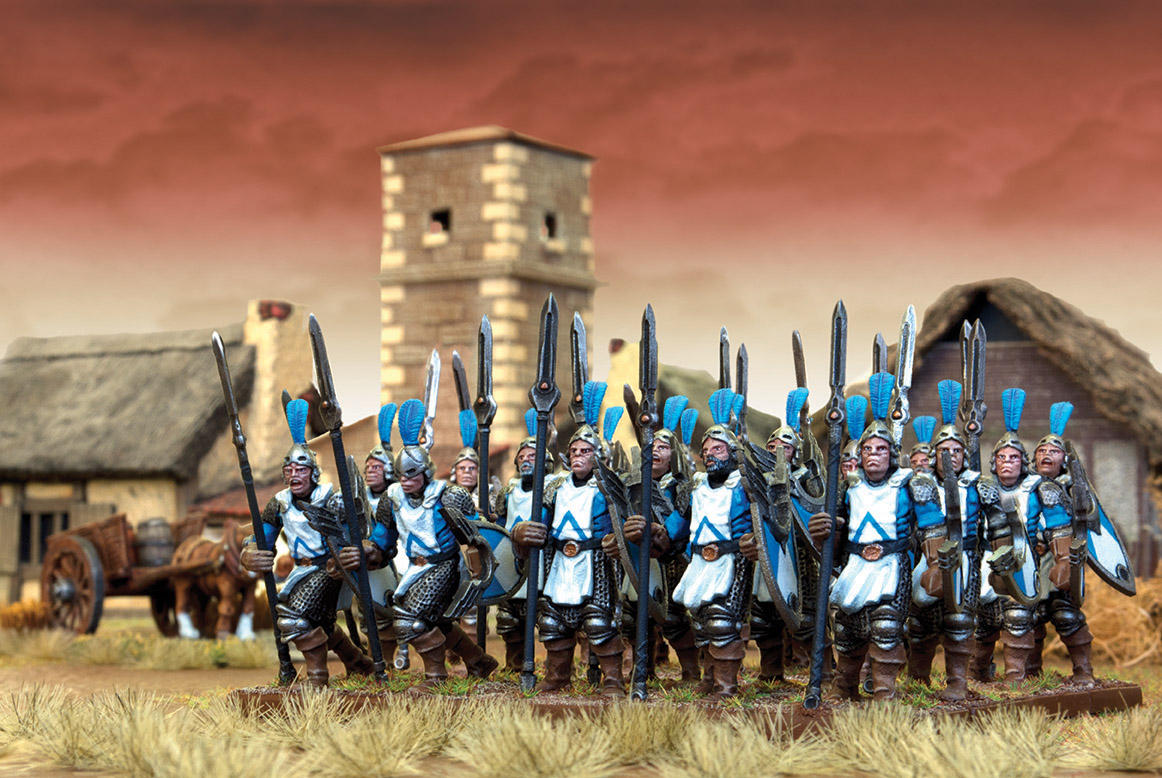
The Empire of the Dwarfs occupies much of the east. The territories of the Elven Kindreds can be found to the southwest. The Hegemony of Basilea, the last true remnant of the Grand Republic of Primovantor, holds large swathes of the northeast, the Successor States bordering it to the northwest. Far to the south, across the Infant Sea, the coastline is rugged and barren, giving way quickly to baking deserts. The ancient Kingdom of Ophidia lays claim to these arid territories. Everywhere between Basilea and Ophidia, smaller states, island kingdoms and independent cities are also to be found. The largest of these is Keretia, a large island, and home of the descendants of the last High Consuls of Primovantor, or so they say, a claim that sets them constantly at odds with the Hegemony of Basilea.
The Wild
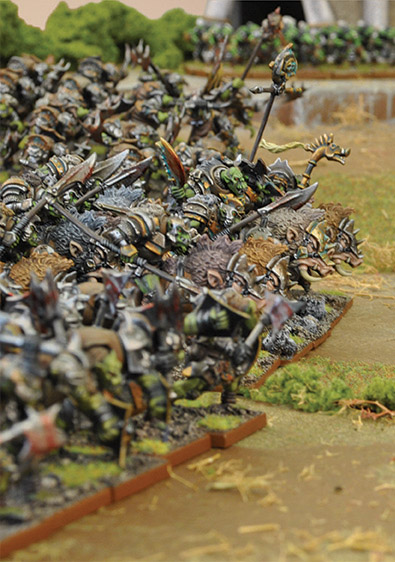
The majority of Mantica is wild and untamed. Many are the places that once held kingdoms or nations but which are now empty, with only ruins to testify to their passing. Other places – the deserts, the high peaks, the deepest forests, the steppes – have never been tamed.
The wilds of Mantica are dangerous and largely uncharted. What was once known about the world no longer holds true, for it has been made and remade time after time, and still bears the deep scars of the God War.
The Forces of Nature
Those venturing into the deep forests of Mantica say they feel they are being watched, and with good reason, for there is a force at work in the world that few – save the Elves – are aware of. The Sylvan Kin worship the Green Lady, a goddess of three aspects. Their lore has it that the Celestian known as the Green Lady did not split into a Wicked and Shining aspect when the Fenulian Mirror broke. With a supreme effort of will, she called upon the spirits of the trees and the beasts of the forests and they lent her their strength, and thus she kept herself together. Yet with the Celestians’ power fragmented, she could not survive for long. To this end, she merged with Liliana, a Wicked One that had somehow retained a sense of morality and was tormented by it. The Lady of Nature then sought out Liliana’s Shining side, and subsumed her too, bringing an uneasy peace to both parts. Thus the Lady is a goddess of two souls, and three aspects: Celestian, Shining and Wicked, and this perhaps explains the fickle yet balanced nature of the natural world.
All of nature yet untouched by evil magic in Mantica will respond to the Green Lady. The Sylvan Kin follow her unreservedly. Other, even more secretive creatures, serve her – centaurs, the eagles, and those wolves and bears that possess the power of reason. Elementals of the deep forest and stone are hers to command, the strange beings known as Tree Herders are among her most ardent servants. These creatures are locked in endless struggle against the despoliation of the natural world. Most often their foes are the Orcs and Goblins, but the logging camps of Men or the mines of the Dwarfs enrage them just as much.
Though the Elves of the Sylvan Kin worship the Green Lady as their goddess, they are too lost in their struggle for survival to be truly controlled by her. The Lady knows that her powers are limited to the wilds, and although she has eyes and ears everywhere in the form of fey creatures, birds, beasts and insects, she has long had need of servants capable of travelling the world independently, to warn her of coming dangers, to predict the movements of enemies, and to understand fully the hearts of conquering warlords and brutish despoilers. To this end, the Lady enraptured a traveller, long ago, and inducted him into the mysteries of nature. It is said that this traveller was a Man of noble birth, a great warrior, who was so enamoured by the Lady’s magic that he swore an oath to renounce his life of battle and serve the Green Lady for all eternity in peace. Thus was founded the ancient Order of Druids, and as their ranks have grown over the years, so has the Green Lady’s influence. Recruited largely from the lands of Men, who alone understand what it is to be possessed of both light and darkness, the Druids are solitary wanderers, who walk the length and breadth of Mantica, ever alert to threats against the balance of nature. If darkness threatens to overwhelm the forces of good in the world, the Druids summon the Lady’s power to quell it. Yet they are ever mindful that should evil be driven back too far, the Lady will adopt the aspect of Liliana, and turn on the forces of good just as surely. Druids must, therefore, remain impartial in all things, lest their meddling cause great harm.
When summoned to war, the Lady is wrathful, having little love for either the evils of the Abyss, or for the smothering rectitude of the Shining Ones. The Sylvan Kin hold a hope that the Lady will restore balance to the world, reuniting the Shining Ones with their Wicked halves, bringing peace for the first time in thousands of years. This peace is itself to be feared, for it is the peace of the unsullied glade, of the untamed river. Should it come to pass, no city will remain.
The Abyss
Far to the northeast of the Infant Sea, amidst the shattered, soot-stained remnants of Winter’s glaciers lies the greatest wound inflicted upon the world in the God War, a great pit in a land made ruinous by its presence, lit ruddy by lava aglow deep within. Here the last of the wicked gods reside, twenty-seven in number, their dark magic spewing ceaselessly into the world, twisting Men and nobler creatures into dark images of themselves.
A great rent in the ground, the Abyss is many miles deep, a fissure cleaved into the centre of the earth in past ages. A pall of smoke hangs above the Abyss, so that it and all the lands about it are shrouded in unnatural, perpetual night. These clouds of ash and soot are lit forever by the ruddy glow of fire, the beating heart of the earth, exposed to the cruel air. The Abyss is a terrible wound; a mortal wound, some say, one that has never healed and never will, and it bleeds. Plumes of molten rock spew in towering fountains into the sky. Poisonous smoke belches from the ground, hanging like a toxic miasma to choke any creature that strays unwittingly into it. Expanses of fine ash gather in hollows to drag down and suffocate the living. And always, the ground shakes and rumbles, opening fissures beneath the feet of the unwary.
This is the Abyss, the heart of all evil in the world. Often described in simple terms as a massive chasm in the world, the truth is somewhat stranger and far more insidious. When Domivar smote the ground with the mighty axe of Oskan he created a realm that was entirely otherworldly. Its dimensions are in constant flux, and cannot be thought of nor defined in simple terms like height depth, and breadth. The Abyss is a fiery and nightmarish other-space, existing parallel to the realms of the mortal races above. Its tendrils extend and contract underneath the world, and within its living, fluctuating boundaries, all manner of strange and unique things exist. It is a home and prison both for those evil gods cast down from heaven at the climax of the God War.
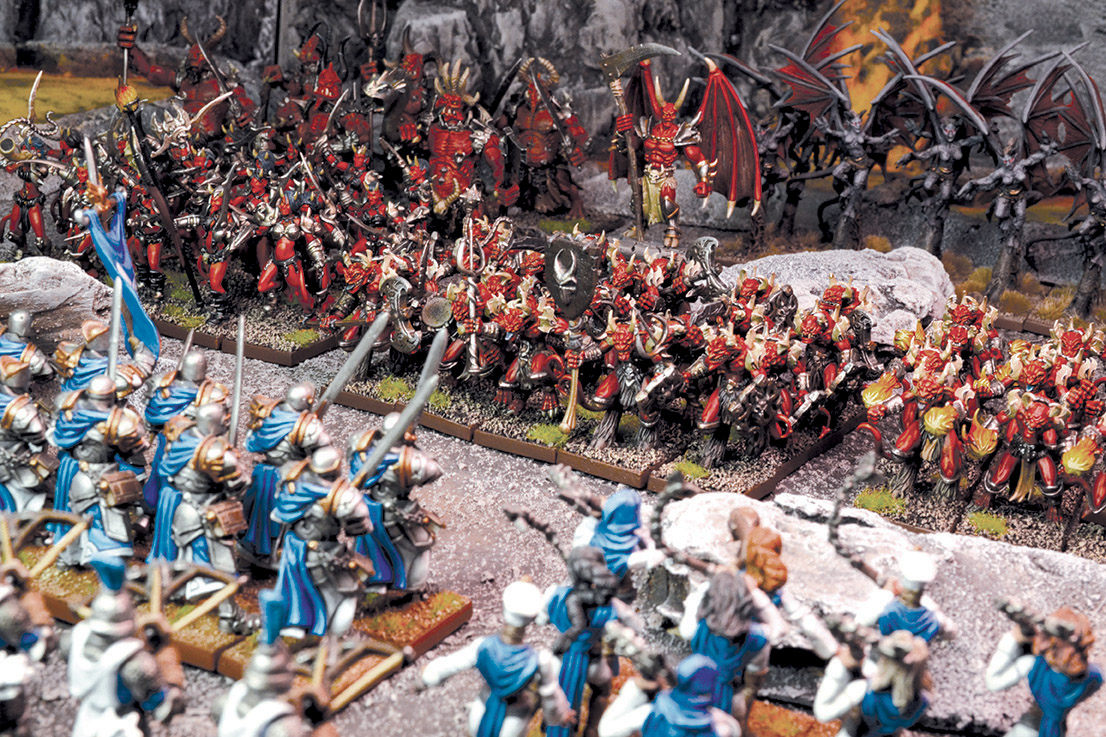
And yet, even here there is life. Up and down the cliffs that plunge to the molten lake at the Abyss’ floor, cave mouths flicker with firelight, home to all manner of wicked, inhuman Abyssals. The air is alive with the sound of industry, screams, dark songs and, if one listens carefully, the insane cackling of the dark deities who dwell in the sinister depths. The foul legions who call this weird place home are many and varied, and yet all are born of flame. When they venture forth into the world above, nations tremble in fear.
Where great power and evil exist, those creatures dark of heart will surely follow. The greatest temple-citadels of the Abyssal Dwarfs rear high at either end of the Abyss, sentinel-mountains made of iron and brass and adorned with all manner of blasphemous carvings. Orcs dwell in great multitudes on the plains and in the mountains around it. Evil creatures prowl its hinterlands, heat-loving elementals slither in and out of its lava, and harpies hunt on the thermals that push up from its depths.
Men, Dwarfs and Elves are to be found here too. Slaves, in the main, dragged to the mines and foundries of the Abyss by raiding parties or in the aftermath of war. But there are others too, those that seek the black power of the evil gods for themselves, and they come willingly into the dark. Few indeed are those brave or foolhardy enough to explore the Abyss, and of those, fewer still are heard from again. It is said that any creature discovered trespassing within that twisted domain will be cursed to a hundred lifetimes of torment, becoming a crazed revenant in the service of the Abyssals.
The Mammoth Steppe
Winter’s time may be long past, and her chill grip receded from the world, but at the poles Mantica is clad still in great caps of ice. Huge frozen cliffs of blue ice as tall as mountains stand sentinel over the world. By day they are visible for a hundred miles, by night the ice groans and roars. Some say this is Winter, that she lives still, and shouts her defiance at the warming sun once it has safely set.
At the feet of the ice cliffs are the Winterlands, the great plains of the Mammoth Steppe. An endless sea of dry grassland that circles the world, these plains are home to great beasts. Brutish horsemen thunder over it, following the herds, and Goblins ride their draft beasts pell-mell across its endless miles. Men from more civilised lands venture here, too, to trade for pelts and mammoth ivory, but they are few in number and hardy. There are a few frontier towns upon the edges of the steppe, heavily fortified with log walls and bastions of permanently frozen earth, otherwise the signs of true civilisation are few. This is a hard land, and the people it breeds, of whatever species, are brutes.
The Ogres
There are few more brutish creatures than the nomadic Ogres, whose huge, mammoth-hide tents dot these plains. Ogres are large creatures, tribal and fierce, who migrate across the steppes in large caravans that are best avoided by any wanderer who doesn’t wish to end up as supper. Though they believe that might makes right, and are aggressive in the extreme to outsiders, they are surprisingly intelligent, with a strange and complex social culture. Their tribes are centred around powerful Warlocks – shamans who draw upon the power of the earth, the endless winds, and the immovable mountains. By dint of their communion with the mysterious Ogre gods, they alone can declare the successor of a tribal Warlord, granting him unnatural luck and fortitude in his coming trials.

Ogres are incredible hunters, possessed of great strength and stamina, and their intricate system of non-verbal communication makes them well-organised and efficient. These hunting practices are regularly pressed into service on Mantica’s battlefields, for many Ogres regularly leave the Mammoth Steppes to serve as mercenaries in far-off armies. However, the call of the frozen north cannot be resisted forever, and all Ogres will eventually return to their tribe, where they will lend their strength to hunting massive beasts, or plundering remote settlements for whatever takes their fancy. Ogres are possessed of the unshakeable belief that anything that can be taken by force – which is most things, given their size and strength – is theirs by right. This frequently leads to battles against the nomadic Men of the plains, with whom they compete for game and trade goods. The horsemen are hardy and warlike, and numerous with it, thus their feud is set to never end.
Goblins, on the other hand, are seen as less of a challenge. The Ogres subjugated the Red Goblins of the Mammoth Steppes long ago, although for the most part the two races live alongside one another peaceably. The Goblins are seen as so weak that they are beneath the attentions of the average Ogre. However, long ago the Red Goblins learned that the only way to get their share of food and shelter on the inhospitable plains – and not get eaten by the many wandering beasts that live there – was to bow and scrape to the Ogres. Now they follow the Ogre hordes on the march, attending them as servants and often fighting alongside them. In return, the Goblins enjoy a measure of protection, as long as they stay out of the way of their lumbering overlords when they’re in a belligerent mood; which is most of the time.
The Winterlands
The Winterlands are a frozen waste, long thought inimical to life. And yet rumours have begun to strike southwards of a small empire, carved from ice and rock, which holds sway over those chill lands. Travellers to the north have reported that the Elves of the Ice Kindred have made a settlement in the Winterlands, but that is not entirely the case. These Elves are not the cold creatures of the Bitter Lands, but are instead vibrant and ambitious, drawn from the dispossessed and disenfranchised from across the Elven realms.

This young Kindred of Elves now rules over a city of ice, outcasts united under the banner of the exiled prince Talannar Icekin. It is said that Icekin used the last of his wealth to pay the Ogres to protect his newfound lands and construct his settlements, while his magic created a city of ice-spires, known simply as Chill, to watch over his domain. Hardy Northmen flock to his banner, as do strange elemental creatures of ice, and packs of vicious Snow Trolls. Warriors come from far and wide to swear fealty to this frozen prince, while his allegiance with the Ogres to the south adds to his strength. Icekin has somehow exerted his influence over disparate tribes and monstrous beasts, forging a Northern Alliance to be feared. If these rumours are true, then Icekin must have discovered something powerful in the frozen wastes, for the Elves swear that Prince Talannar was most unremarkable when he set out from Elvenholme, yet now seems bound for greatness.
The Ardovikian Plain
After Winter’s defeat, her ice retreated back to the pole of the north, and in the south up to the peaks of the Dragon’s Teeth mountains. As this occurred, the Ardovikian plain was uncovered after ages pressed under cruel glaciers. Once home to the richest nine provinces of Primovantor, the ice had wiped it clean. In the nine hundred years since the War with Winter, this plain has
become hotly contested by all the peoples of Mantica and is once again rife with activity. The loess left by the glaciers is rich in nutrients. Young forests swathe large parts of it, surrounding the ancient greenwood of Galahir. Treasures from ancient times can be found in subterranean complexes, and the ice has eroded mountains, turning up many rich seams of ore. Here a Man - or a Dwarf, or an Elf – can make a name for himself.
The Southern Deserts
This expanse of arid desert is truly vast, stretching along most of the lower seaboard of the Infant Sea. Inexorably, day by day it advances, already it has devoured the realms of the Southern Elven Kindred, and much of the eastern plains. In many places, the dunes march unchallenged to the sea. The mysterious kingdom of Ophidia, sustained by its rich river valley, occupies much of the west, precious oases, desert cities and other, stranger kingdoms scattered across its interior. But beyond Ophidia, mysterious ruins, dead trees, and the bones of long-extinct creatures are all that challenge the whispering sand for space.
Further south are the Cracked Lands, a fractured landscape of parched stone and craters. Some sages maintain this was the site of a powerful kingdom, flattened by a falling comet during the God War, others that it is a site of evil to rival the Abyss. Those of the Noble Races that have crossed the desert and ventured into the Cracked Lands are but a handful in number, for there is insufficient water to sustain a camel there. On the far side these travellers assert the land abruptly changes, becoming verdant and green, hills cloaked with jungle and teeming with life.

The Lands of the Elves
Elvenholme
Winter’s Final Gift, they call it, the sinking of much of Elvenholme under the raging sea, an inundation so swift and terrible it slew fully half of the Elven race. Once united, the Elves now coexist as an uneasy federation of interdependent kindreds, who pay but lip service to the Mage-Queen residing at the Twilight Glades.

The remaining members of the Western and Eastern Kindreds, inhabiting Elvenholme proper, still stand united. Those few who survive in the Northern Reaches remain aloof and look to their own affairs. To the very far north, the followers of the exiled prince Talannar Icekin have taken the newly revealed Winterlands as their own, and grow apart from what most Elves would regard as the true way.
Though bloodied, the Elves remain unbowed, and are slowly returning from the brink of extinction. Throughout the world’s cities it is possible to find Elven quarters, where itinerant communities of dispossessed Elves have made their homes. Likewise, the Young Kingdoms are dotted with delicate Elven castles, the homes of those who have tired of the melancholy of the elder lands. Vital, ambitious and energetic, the Elves of the Young Kingdoms offer the greatest hope to all Elfkind.
The City of Walldeep
Therennia Adar is known commonly as Walldeep, so named for the great ring of rock that surrounds the city, protecting it from the sea which stands deep all about it. Raised by the heroic mage Valandor at the time of the flood, and fortified still by old magic, the walls stand only forty feet above the wave-tops, yet plunge many hundreds to the city behind. Aside from the Brokenwall Islands, it is the last piece of the ancient heart of the Western Kindreds that exists today. Those that survive are known as the Sea Kindred now, and their ships skim the waves that cover their lands.
The Sea Elf soldiers who patrol the wall’s parapets do so with sun on their faces, but behind those walls, the city itself lies in perpetual shadow. Walldeep is a powerful yet sad place. Only the Spire of Ages rises above the ring of stone into the light. The Spire of Ages is a holy site. Valandor the Great’s broken form lies upon a couch of sea-ivory in a room at the very top. Time flows differently around the hero’s corpse, which shows no sign of corruption, even after almost a thousand years. There are those who maintain that Valandor merely sleeps, and that when Therennia Adar and Elvenkind are once again threatened, he will rise up and ready himself for battle once more.
The Twilight Glades
The Elves who inhabit this most ancient of Elvish places mutter darkly that their time as a people is done, and that it was their kind’s forsaking of tree and branch for stone and steel that brought them low. The Twilight Glades are the heart of Elven culture, the home of the High Marshall and the Mage-Queen and her court. Disunited they might be, but the Elves still heed to the Mage-Queen’s words, and she is the closest they have to an overall leader.
The Twilight Glades lie at the centre of a range of hills on the southern shore of the Infant Sea. This is a magical realm woven into the forest. By uncertain roads one might reach the city of Ileuthar, a place like no other, grown from living trees. At its centre are the glades after which the entire kingdom takes its name. The Twilight Glades are a dense maze of ancient trees whose paths change constantly, and the deepest are unsafe for all but Mage-Queen Laraentha Silverbranch to tread.
These glades are but a faint shadow compared to those that once cloaked the slopes about Therennia Adar. Their lesser nature is a constant reminder to the Elves that they live at the twilight of their race, hence their name. Even so, great magic can be found in their dappled clearings and shadow-choked copses. Representatives of all the kindreds can be found in Ileuthar: city-merchants who dwell in the lands of men, Sea Elves, the nomadic Eastern Kindreds, dangerous Ice Elves, and even, it is rumoured, the envoys of the Twilight Kin. It is hard for men to understand how such mortal enemies can sit and talk and share bread and wine, but Elves are not as men. Ileuthar is neutral ground for all Elves, and all of the Kindreds, no matter their attitudes to others, are welcome to the court.
Ileuthar and the Glades are especially beloved of the wild Sylvan Kin. Many of the Mage-Queen’s attendants are drawn from their number, and it is they who convince the trees to take their useful shape through song.
The oldest trees in The Twilight Glades were seeded from the long-drowned world-tree itself, and it remains one of the most magically potent places on the planet. The walls between the layers of existence are thin in the Twilight Glades. At times of great need, the Elves will cross over through The Glade of Ways, a magical portal that is said to lead anywhere and everywhere. When they do so, they leave Mantica entirely, and walk the mysterious otherworldly roads called the Shadow Paths. This is perilous indeed, and not lightly done.
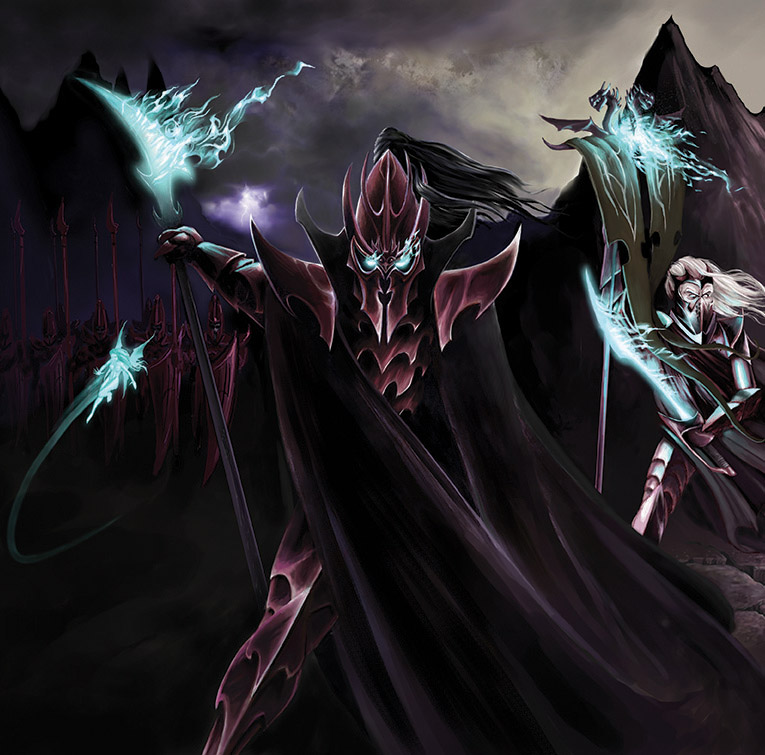
The source of the Elves’ great magical power, the glades are coveted by many others, none more dangerous than Mhorgoth. Rumour has it that he dreams of seizing the Glades, opening their sorcerous portals and allowing the realms of the dead to mix freely with that of the living. Should this happen, the world would become a hellish place indeed, with Mhorgoth its fell king.
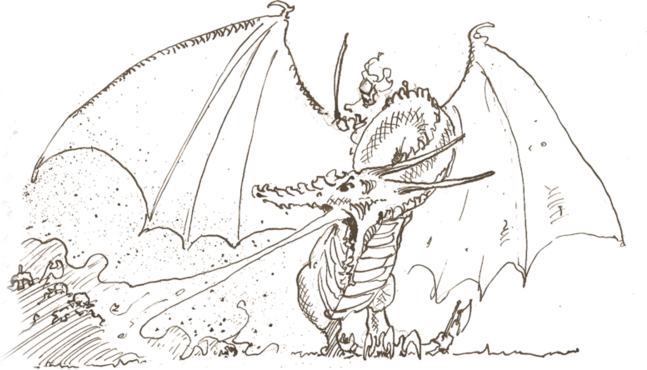
The Mountains of Alandar
West of the Twilight Glades, the peaks of Alandar rise dramatically, home to the dragons and their masters. The slopes of Alandar are covered in lush, warm forest, home to a stunning range of game, strange monsters, mysterious woodland denizens and dragons alike.
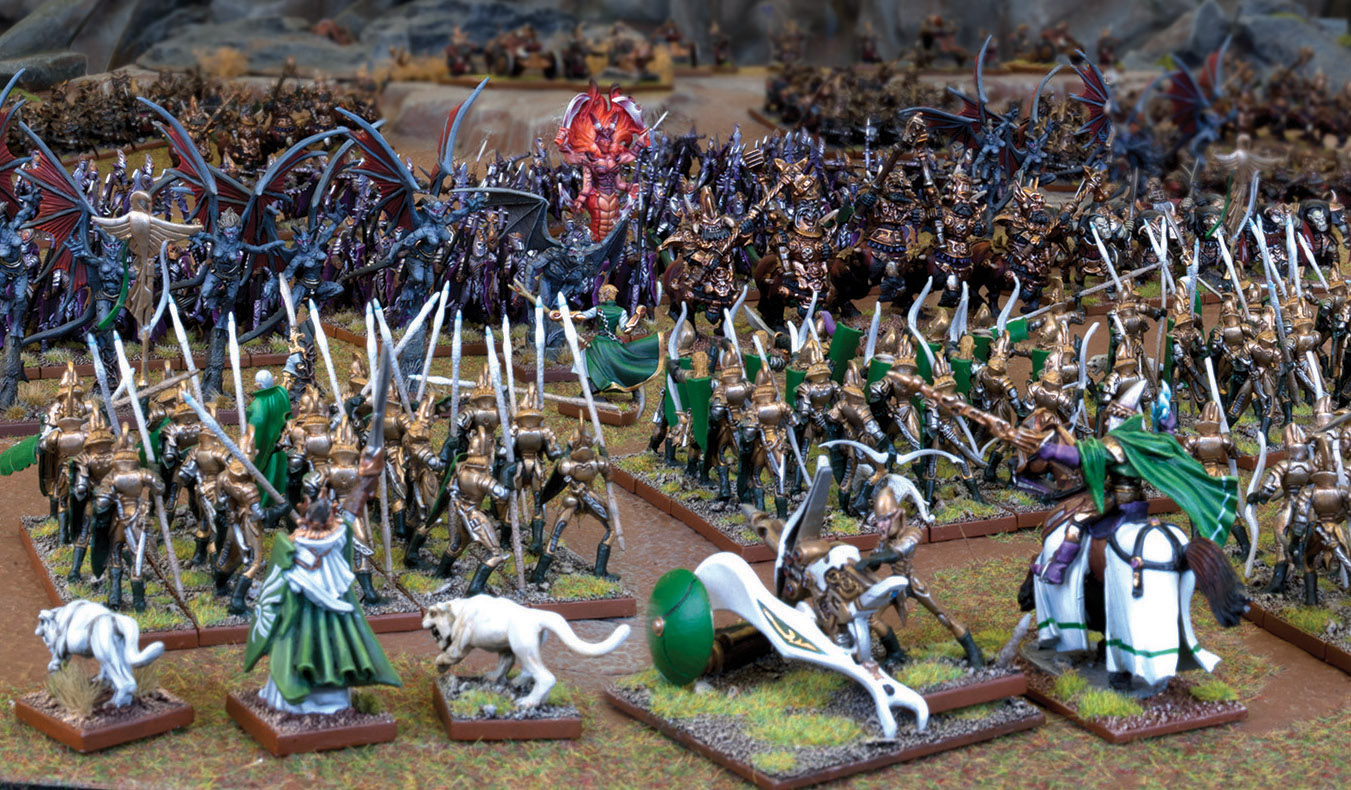
The Eastern Reaches
Where the mountains of Elvenholme meet the plains, the Elves of the Eastern Kindreds make their homes. In ages past, living among the rich life of the savannah gave these nomads an adventurousness of spirit and joy of being that made them renowned worldwide. But those days are done, replaced by dark times. The savannah has been all but swallowed by the ever-expanding Ophidian Desert to the east, and the great beasts and Drakons that once roamed there are almost gone. Some of the Eastern Kindred have managed to retain fearsome Drakons, which they use as monstrous steeds in time of war. Though their numbers are few, and dwindling still, the strange symbiosis of Elf and Drakon is a sight to be feared in battle.
The Southern Kindreds
The Ophidian desert has already swallowed most of the lands of the Southern Kindreds, leaving but a few scattered cities alone in the sand, whose hinterlands, preserved by magic, are eaten away yard by yard as time marches on. These elves are hardy and stubborn, and their staunch defence of their ancestral territory has become legend among Elvenkind.
The Mouth of Leith
To the far east of Elvenholme, in the desert before one reaches Ophidia, lie the canyons of Leith. Deep and dark and verdant are these, ringing with the roars of creatures thought dead for aeons. Others live here too, the dark kin of the Elves, refugees from the times of the God War who have
turned their backs on all that is divine in their bitterness. Rumour has it that they preside over a subterranean kingdom accessed only from the bottom-most canyons. Those that venture there uninvited do not return.
The Bitter Lands
The last lands before the Great Ocean, the Bitter Lands are a windswept, miserable place far to the Northwest. Savage seas surround them. They are cloaked in snow for six months of the year, lashed with freezing rains the rest. Ice smothers their northernmost reaches. In this inhospitable place the outcast Elven King Tyris Valellion makes his home. For two thousand years he and his clan have dwelt there, far from the light of Elvenholme, slowly transforming into a unique kindred in their own right – the Ice Elves. They lived here even when Winter was at her height, surviving by taking her magic and turning it against her. The inhabitants of the Bitter Lands are pale and wan, their skin cold to the touch. They are masters of Ice Lore, and can summon up blizzards or storms of sharp-bladed hail on a whim.
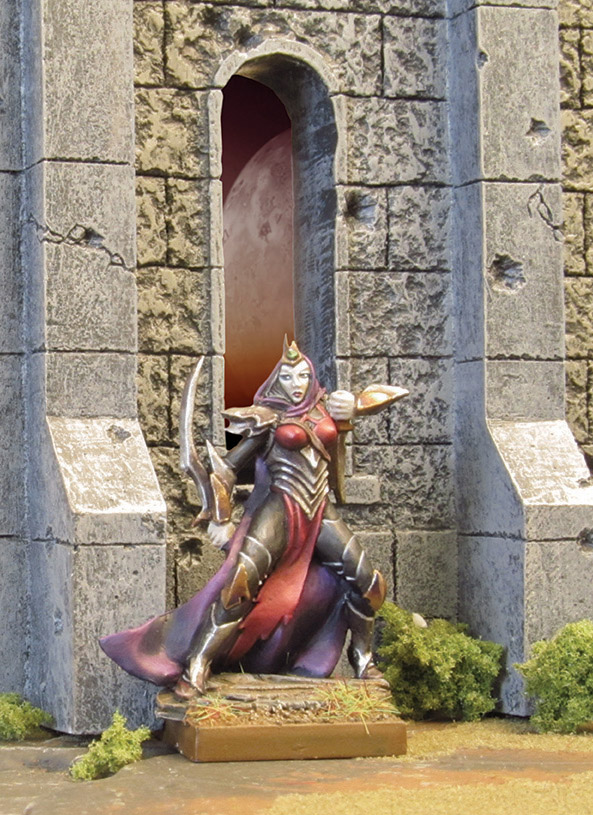
A blade of ice a league across thrusts down from the far north, barring the land bridge that joins the Bitter Lands to the continent. This is Tyris’ Gate. At his command, it will pull back with a chill groan fit to shatter the heavens. This makes the Bitter Lands an unassailable fortress. Should any enemy of the Elves make it over the seas or the ice, then they must deal with the ice-tipped spears and implacable hostility of the island’s inhabitants, and their terrible storms.
The Forest of Galahir
Upon the Ardovikian plain north of the Dragon’s Teeth Mountains, at the heart of those squabbling principalities called the Young Kingdoms, is the forest of Galahir. The trees here are the mightiest on all of Mantica, their trunks as thick and tall as any tower of stone built by Man, Elf or Dwarf. This is the home of the Sylvan Kin, and the centre of the power of the Green Lady. The Sylvan Kin have dwelt here since the dawn of Elven civilisation. As the other kindreds grew further away from their roots, this Kindred embraced them. They would have nothing of the stone cities or the plains or the deserts and mountains their kin conquered, instead they remained where their ancestors had always dwelled. After the fall of the Celestians they became favourites of the Green Lady, and their magic helped keep her whole at the time of the sundering. Throughout all the long flowering of Primovantor and the horrors of the God War, the Sylvan Kin remained here. Their forest has grown and shrunk and grown again, but its great heart has always remained.
When Ardovikia and the northern provinces of Primovantor were smothered in ice, the Sylvan Kin called upon the power of the Lady. Their realm was surrounded and isolated by the ice, but it was not crushed. For three hundred years the trees slept, bare of leaves, but they did not die. When Winter was defeated, the forest bloomed again, ready to bring life back to Ardovikia as the ice retreated.
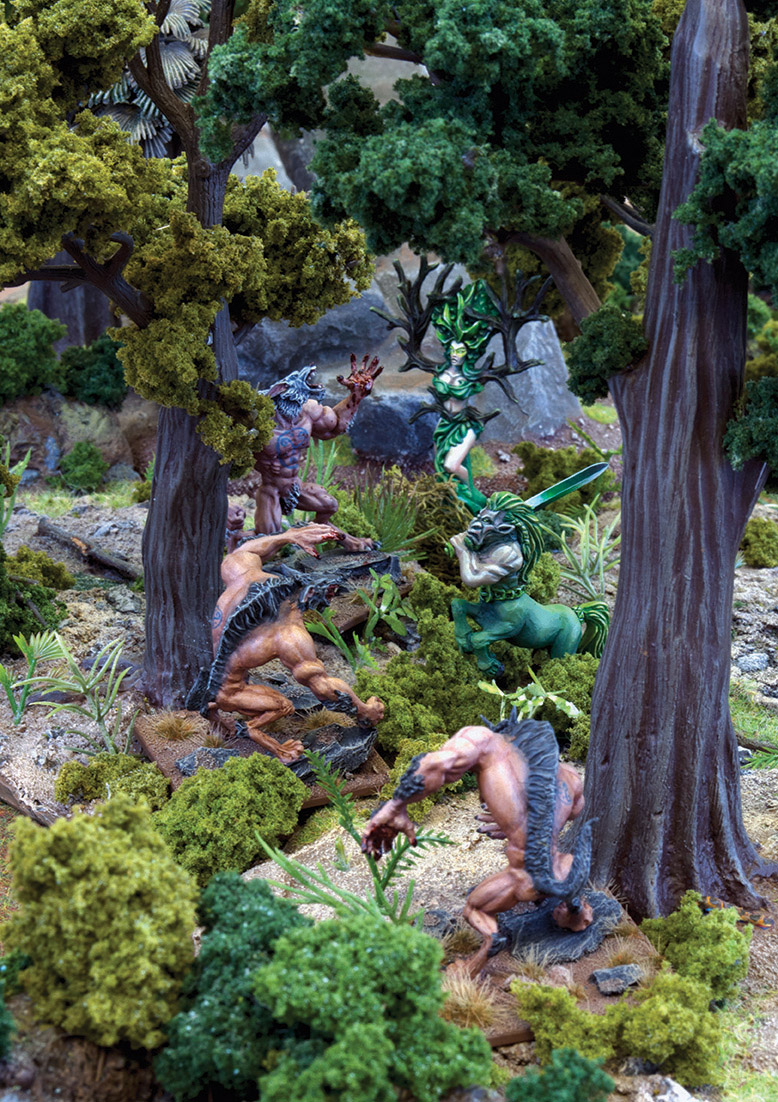
The Brokenwall Islands
Strung across the mouth of the Infant Sea, the Brokenwall Islands are the last redoubts of the Sea Elves. Their elegant castles stand upon shining white cliffs, looking at the ocean in every direction. These are places of circling gulls, the crash of waves and the sigh of the wind. The salt tang is forever on the air, and the Sea Elves would have it no other way.
The Lands of the Dwarfs
The Golloch Empire
For many millennia the Dwarfs of Abercarr held themselves apart, content to hide in their halls while the ice pressed ineffectually down upon their mountain roofs. Only reluctantly did they agree to join the war against Winter, and have cursed the decision ever since. They lost many holds and more kin to the war, and once it was done, they turned their backs upon the shattered kingdoms of Elves and Men, retreated underground, and shut their mountain gates.

For ages insular, the long reign of King Golloch has turned the Dwarfs of Abkhazia outwards. In recent centuries, they have conquered land after land. Today, their empire stretches far into the little-known east, and knocks upon the very gates of Basilea to the west. Tenacious, hardy and determined, the Dwarfs have an unparalleled mastery of metal working, which they use to create marvellous artefacts and engines of war. A Dwarven army on the march is a glorious thing to behold, but terrible, for their approach means only war and subjugation.
Abercarr
Abercarr is large land buried by towering peaks. The bulk of it is a peninsula bounded to the north by the High Sea of Bari and the Low Sea of Suan, and to the south by the Infant Sea. The mountains are for the most part impassable and barren, their peaks cloaked in snow and glaciers, their shoulders forbidding, bare rock.
The Dwarfs have carved roads into and under the mountains, linking their vast cities with hidden, fertile valleys where they work the land. In places, entire mountains have been reformed to the Dwarfs’ tastes, making them sculpted cities of living rock, their flanks aflame with the glow from hundreds of intricate windows. None of these holds is more impressive, nor as populous as Caeryn Golloch, the imperial capital.
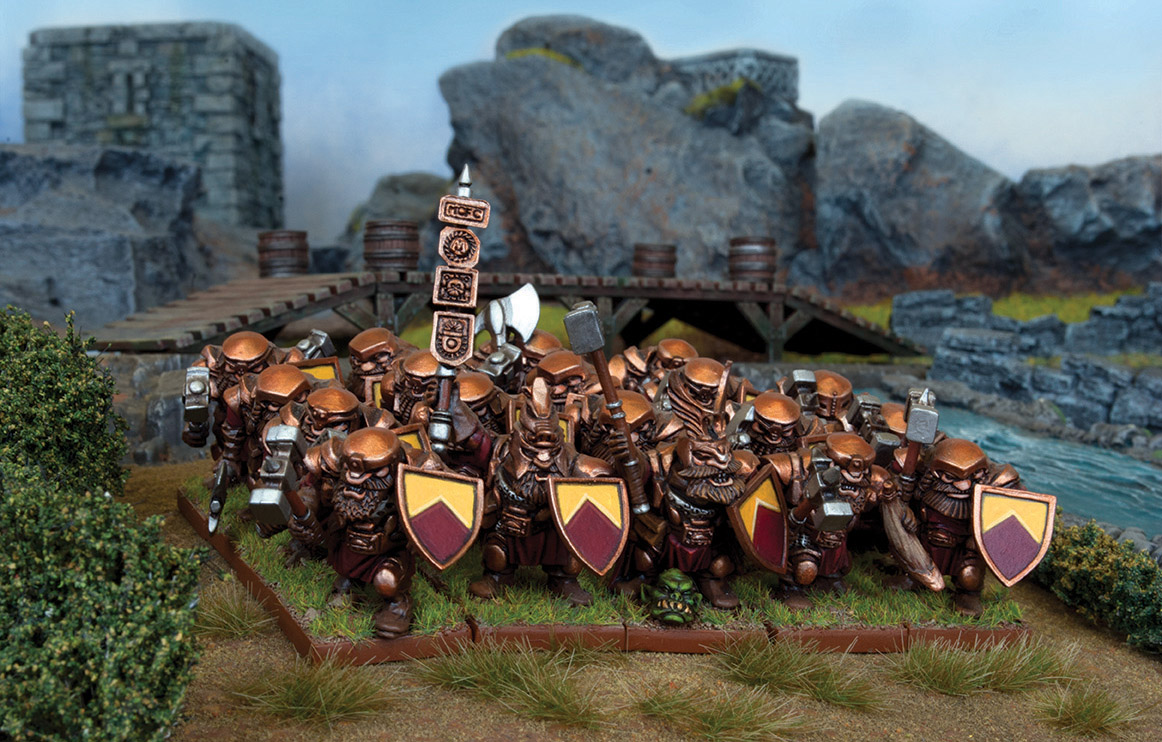
To the east the mountains gradually dwindle to plains and forest. It is here that the Dwarfs have made most of their conquests, and the tunnels of the mountain people extend far out to these vassal cities and states. Rebellion is impossible when retribution lies under one’s feet.
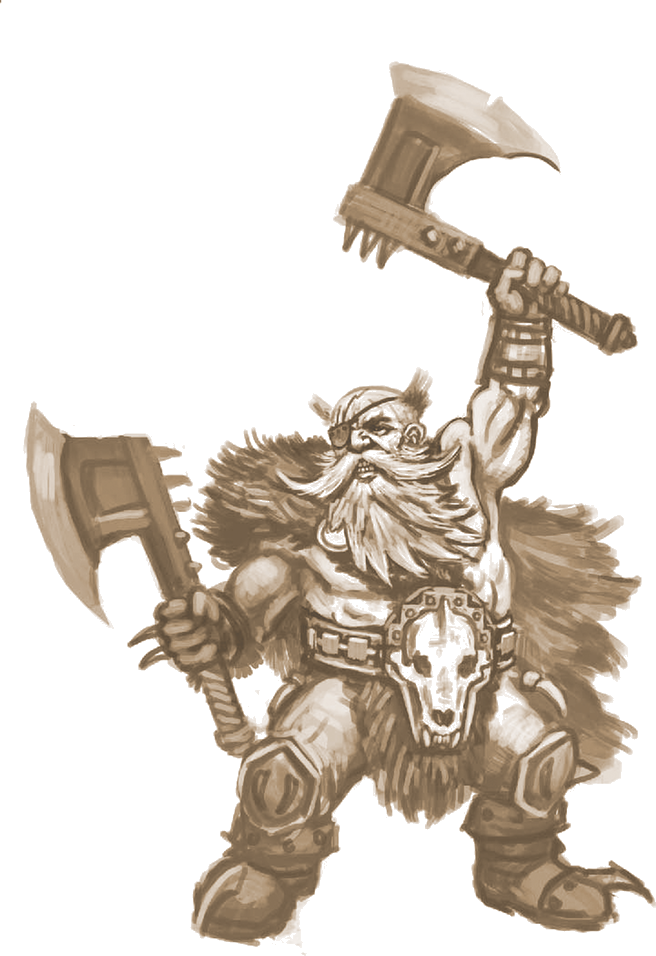
The west is a different story. The Dwarfs’ realm abuts Basilea. In the time of Primovantor, the lands intersected with each other peaceably, the Dwarfs dwelling underground, and Men on the surface. Beneath the Plains of Diffeth, the ruins of Dolgarth, the Dwarfs’ ancient capital, attest to this with their mix of mannish and Dwarven styles. But that was long ago. Dolgarth’s halls were flooded when the ice receded, and they are now home to unspeakable horrors. Many adventurers brave the long dark of those Dwarf halls, lured by the promise of ancient treasure and forgotten lore, though few ever return.
Basilea has become increasingly hostile to the Imperial Dwarfs, seemingly at the insistence of their gods, and the land between the two civilisations is often contested, with Golloch’s armies getting within cannon shot of the City of the Golden Horn’s towering walls on two occasions. To the south, the mountains of Abkhazia shelve abruptly to the northern reaches of Ophidia, and this border is heavily fortified. Along the Southern Watchline every peak is a redoubt. Subterranean roads wide enough for armies link every mountain-castle, lesser forts at three-mile intervals between. Gigantic runes of warding have been carved into the cliffs. Against what evil, the Dwarfs will not say.
The Great Cataract
Not all Dwarfs bend their knees to the might of Golloch. Over the Great Cataract that separates the High Sea of Bari and the Low Sea of Suan, the citadels of the Free Dwarfs and the Imperial Dwarfs glower at one another, the northern tower marking the southernmost limit of the lands of the Free Clans, many of whose number can also be found adventuring in the Young Kingdoms, while the southern tower stands sentinel over the border of Golloch’s Empire.
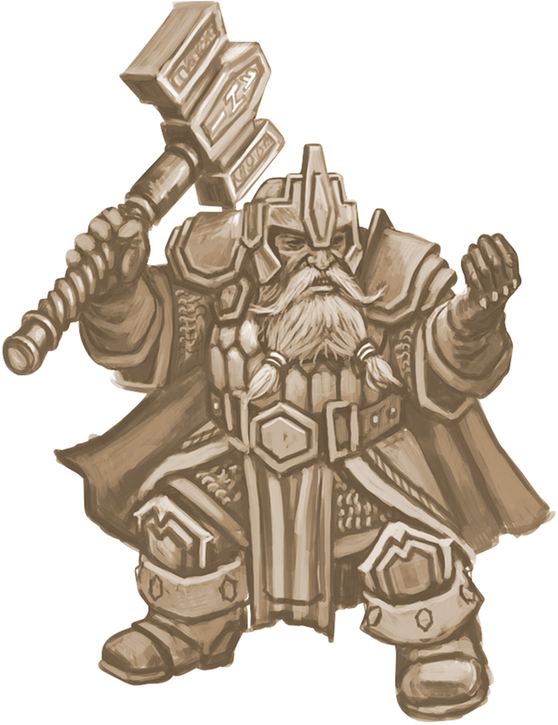
The Great Cataract is an immense waterfall, so broad that it is only possible to see from side to side under very particular conditions. Here the High Sea of Bari thunders down a cliff three hundred feet high to join the Low Sea of Suan. The roar of the cataract is deafening. Around its edges Sirens play, cloaking their vile forms in glamours of beauty and allurement, luring the unwary to their dooms in the water of Bari or over the edge of the waterfall itself.
In the centre of the Cataract is Culloch Mor, a tree-cloaked rock topped by a simple altar of unknown origin. Here the Free Dwarfs and Imperial Dwarfs will come to treat, dragging themselves along the Chainway.
The Chainway is the only direct way between the lands of the two Dwarf factions. A heavy chain that leads, rock to rock, from both shores to Culloch Mor, the Chainway allows ferries to traverse the very lip of the waterfall in safety. It is a spectacular if terrifying journey. As in the case of much Dwarf engineering, the Chainway is a marvel of the modern world.
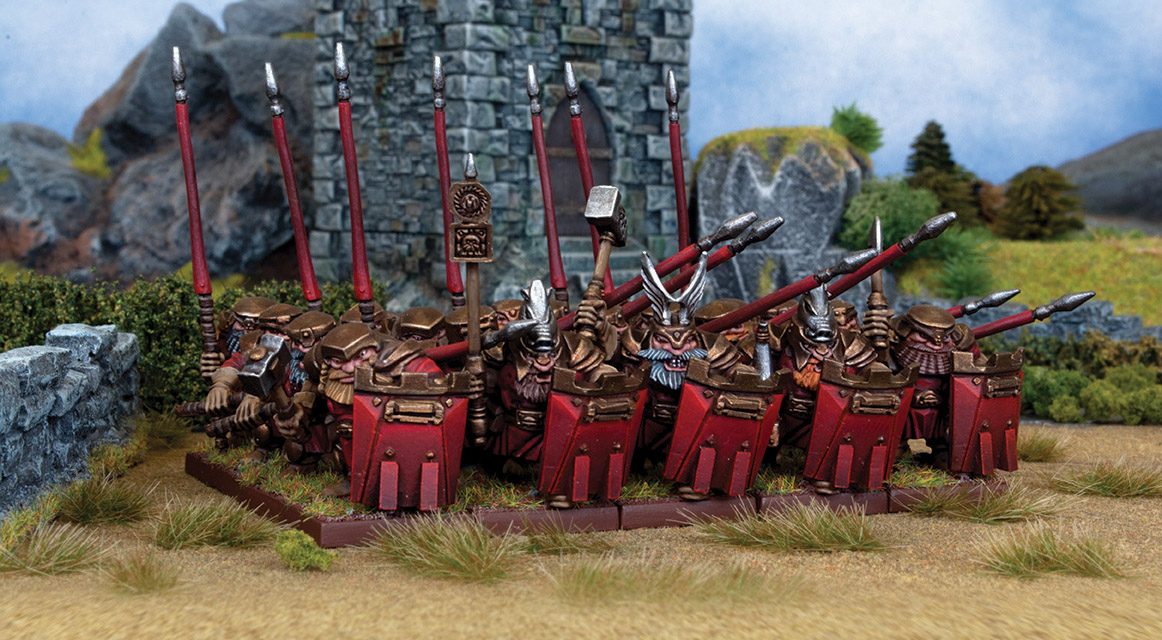
The Free Dwarf Lands
After the God War, the Dwarfs expanded northwards, founding many new holds in the Halpi Mountains above the twin seas of Bari and Suan. The Halpi emanate outward in a large triangle from the Great Cataract, and penetrate deep into the Mammoth Steppe. These mountains are rich in gems and ores, all things the Dwarfs love above all else, and the number of these holdings expanded rapidly as Dwarfs flocked north to exploit the riches of the mountains. They did not heed the warnings of the Warsmiths that the Halpis were dangerously close to the influences of the Abyss, which spits its evil into the world not far from the eastern slopes of the mountains. The Northern Dwarfs scoffed, and a few braver souls even ventured into the dark lands that bound it where the very rarest metals may simply be picked up from the ground.
Under Winter’s dark reign, the ice ground over the tops of the mountains, but the Dwarfs did not care. The Dwarfs of the north refused to answer the call of Elves and Men to war, bragging that ice could do them no harm in their mountain halls. It is perhaps fortunate that they did so, for Winter unleashed a surprise attack upon the northern Dwarfs. A tide of Abyssals, Orcs, and Goblins poured into their holds. Smaller and less well-defended than those of the south, many fell.
The Free Dwarfs come from the five holds that survived the fall of the north. Cwl Gen, Gars, Llyfanifeg, Marn and Rhyn Dufaris. Their numbers have been bolstered of late by Dwarfs fleeing from Golloch’s tyranny (as they have it) and Dwarfs drawn from those communities scattered in the cities of Men. Like the Imperial Dwarfs, the Free Dwarfs are undergoing a period of expansion, but their conquests are their old holds. In the darkness under the Halpi mountains a war is being waged, as the Free Dwarfs attempt to expel the Orcs and Goblins who have taken up residence in their ruined homes. Victory is far from assured, for evil things of immense power now dwell in the deep places of the world. Indeed, word spreads across the holds that one of the greatest kings of the Free Dwarfs, Thorrik Rockfist, has been slain by none other than the necromancer Mhorgoth, and that his city, Ironhold, built upon the banks of the Redgar River, is now a haunted place of shambling revenants and mournful spirits. If this is true, then the Free Dwarfs are in dire peril, attacked from all quarters by Orcs, Abyssal Dwarfs and Undead, with not even their Imperial kin to call upon for aid.
Tragar
What became of the northern Dwarfs who had established mining communities around the Abyss was not to be discovered until hundreds of years later. Drawn there by the promise of riches, these once noble-hearted creatures were twisted by the dark whispers of the Father of Lies. Now their hellish industries surround the Abyss. Their cities stand at either end – Zarak and Deiw – bywords for evil and pain. They call their kingdom Tragar, and all fear it.
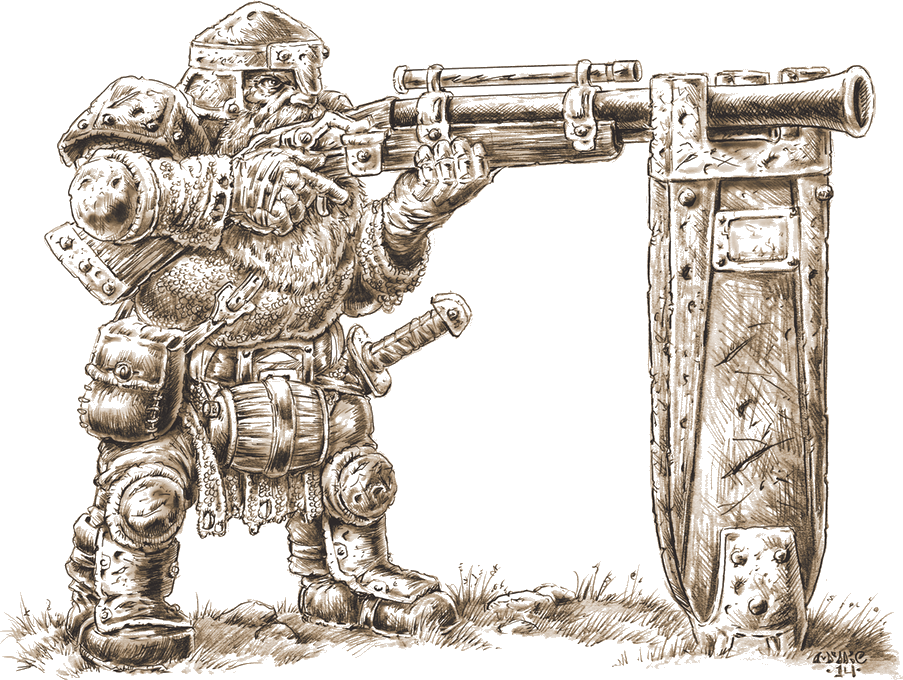
The smoke of the Abyss chokes the air, the ruddy light of the fires in its depths make it impossible to tell if it is night or day. The air rings with the sounds of the Abyssal Dwarf’s industries and the screams of their slaves. Thousands are sacrificed daily, pushed from the
Gift-Piers of Zarak and Deiw, long stone arches that end high above the broil of the pit. All for the greater glory of Oskan and his twenty-six Abyssal Lords.
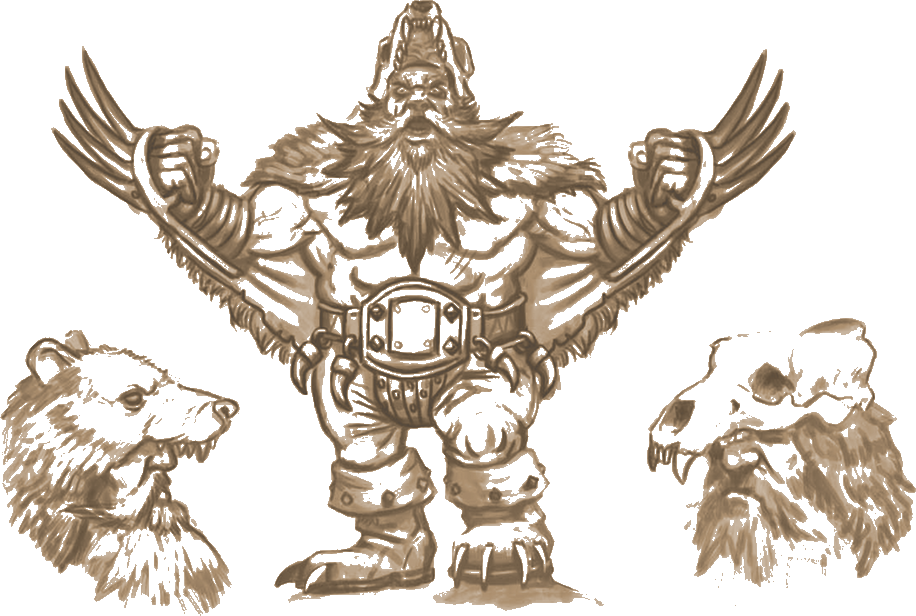
Day and night the fires of industry burn bright, and instruments of war are churned from great forges on a scale never before seen. The self-proclaimed Overking of the Abyssal Dwarfs, Zerkziz of Zarak, is consumed by a desire to destroy his former kin. He looks to the burgeoning kingdom of Golloch, and wishes nothing more than the subjugation of every Dwarf who serves him. But to reach Abercarr, Zerkziz must first destroy the Free Dwarfs that stand in his way. With their holds under his command, his armies would surely swell beyond measure, and the lands to the south would be his to conquer.
The Lands of Men
Primovantor
The Grand Republic of Primovantor was the greatest civilisation Mantica had seen, at its height covering a third of the known world. The time of Primovantor was one of high art and high science, a beacon of hope against the relentless chill of Winter’s Age of Ice, the last era of the God War. It was the High Consul of the Primovantians who urged the ending of Winter, and thus sealed the fate of his own land. Most of Primovantor that was not ruined in the war was drowned under the Infant Sea. The holy city of Primantor itself survived. The city is now mostly ruinous, trees fill its wide boulevards, and the inhabited parts are little more than villages, divided by a wilderness of crumbling masonry.
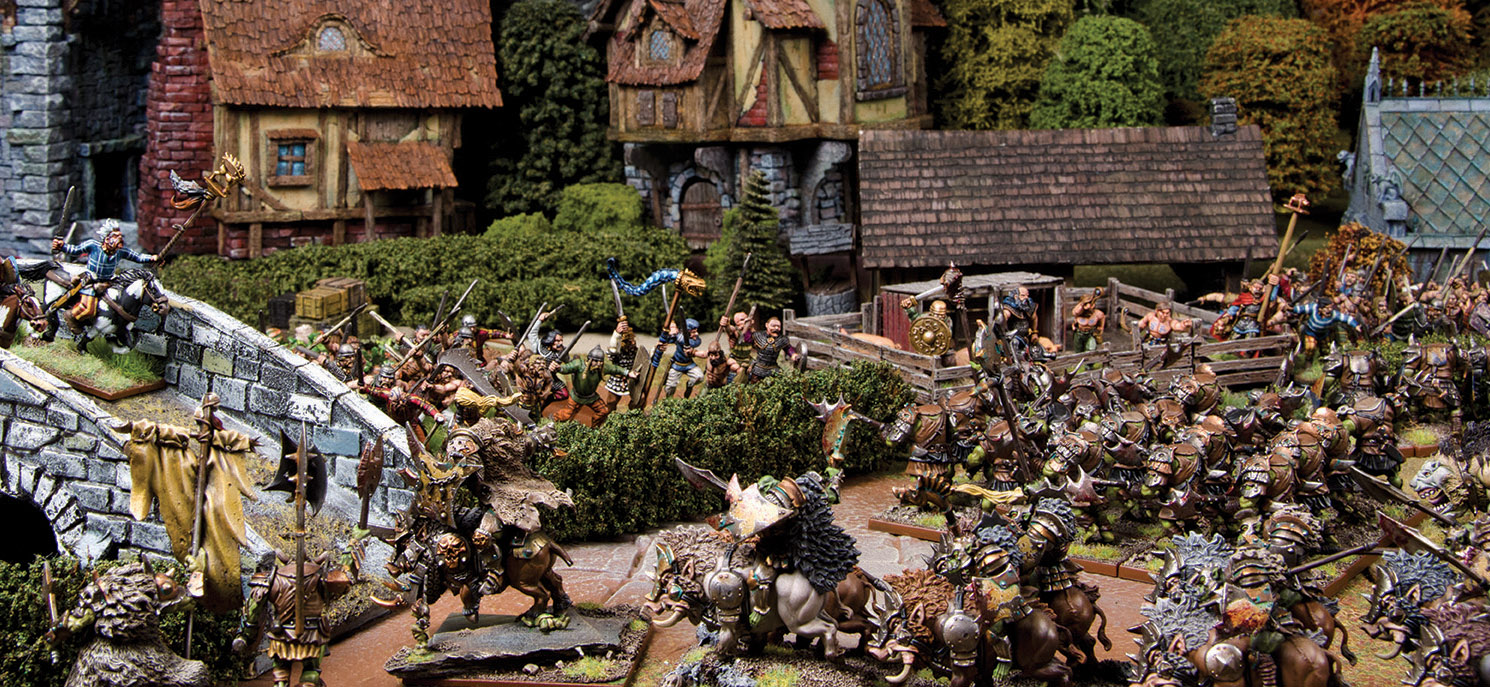
Some of the glory of Primovantor did survive, in Basilea, the Eastern portion of the Republic. Basilea persists to this day, albeit in much diminished form and certainly not as a republic, but as the hide-bound Hegemony.
The Successor Kingdoms
The High Consul dead, much of the land laid waste, the shock of the inundation was the final blow to the tottering Republic. The remnants of it broke up into warring statelets, and much was forgotten. Dozens of independent city states now rule small kingdoms all over the peninsula of Primovantia, and at the feet of the Dragon’s Teeth to the north and west. The greatest of them all is Valentica, which occupies the entirety of the lands bearing the same name. The people here are great traders, keen-eyed sailors with a thirst for adventure, and hold close ties with the Sea Elves. Also of note is the mountain duchy of Sathoi, a provider of skilled mercenary companies, and the city-state of Geneza, another sea nation of traders, and great rivals of both the Valenticans and Sea Kindred. Geneza is unique in that it is built atop the ruins of an earlier city, drowned by the sea. Unable to escape, the Genezans simply built upwards, and modern Geneza sits upon the waves like a stone ship. Primovantor itself persists as one of these states, although it is greatly shrunk in size, its inhabited portions are like villages surrounded by a harsh wilderness of broken stone and briars.
For the main part small and individually weak, it is these same kingdoms now that see the flowerings of rebirth. For many years little more than barbarian realms, the city states, dukedoms and petty principalities of the coast and mountains have reached fresh levels of understanding, while art and science once again flourish. Over the mountains to the north, realms expand and
new countries are born from the virgin lands of the Young Kingdoms, often with the Men of the Successor Kingdoms as their founders.
The Hegemony of Basilea
Conservative by nature and paralysed by ritual it may be, but Basilea still reflects some of the ancient glories of Primovantor. Its cities are the largest, its princes the richest, its mages the most powerful of all the kingdoms of Men. Basilea insists that it is the only true protector of Primovantor’s legacy. Temples are still maintained to the long-gone Celestians in Basilea, while the worship of their good aspects, the Shining Ones, is an integral part of life.

It is a kingdom where time has stood still, where some of the glories of the elder days might still be found. Noble Paladins devote their entire lives to battle and prayer, undergoing arduous quests to prove their purity to the Shining Ones. Many Orders of the Sisterhood guard the borders. Purity, courage, and strength are the watchwords of these warrior virgins.
The Hegemon is king and high priest both. It is within his power to appeal directly to the Shining Ones. These remaining noble aspects of the Celestians dwell atop the mountain of Kolosu, an impossibly high pillar of rock, and from there they watch over the Hegemony. They rarely manifest directly, although it is not unknown for one or the other of them to take to the battlefield even in these lesser times, but will send their servants to the aid of the Basilean armies, should the occasion warrant it. These are the Elohi, angelic beings of immense power, who appear in the guise of beautiful, winged humans armoured all in gold. In war they are all but unstoppable, as terrible in combat as they are merciful and kind out of it.
But alongside the purest aspect of true faith and benevolence, Basilea has its sinister side too. Free thinking of any kind is not easily tolerated, and Basilean culture therefore remains hidebound and unchanging. Periodic panics about agents of the Wicked Ones sweep the nation, leading to innocent and guilty alike being condemned to death by mass drowning in the Cleansing Pools.
The Hegemon does not rule unchallenged; blood feud is all too common, driven by fires of honour and religious fervour that cannot be quenched. Orcs press upon Basilea from the north, while relations with the Dwarfs to the east are at their lowest ebb.
And atop their pillar of stone, the Shining Ones watch, for the most part silent. Protectors of Mankind, some say, capricious immortals who toy with the lives of lesser beings, say others.
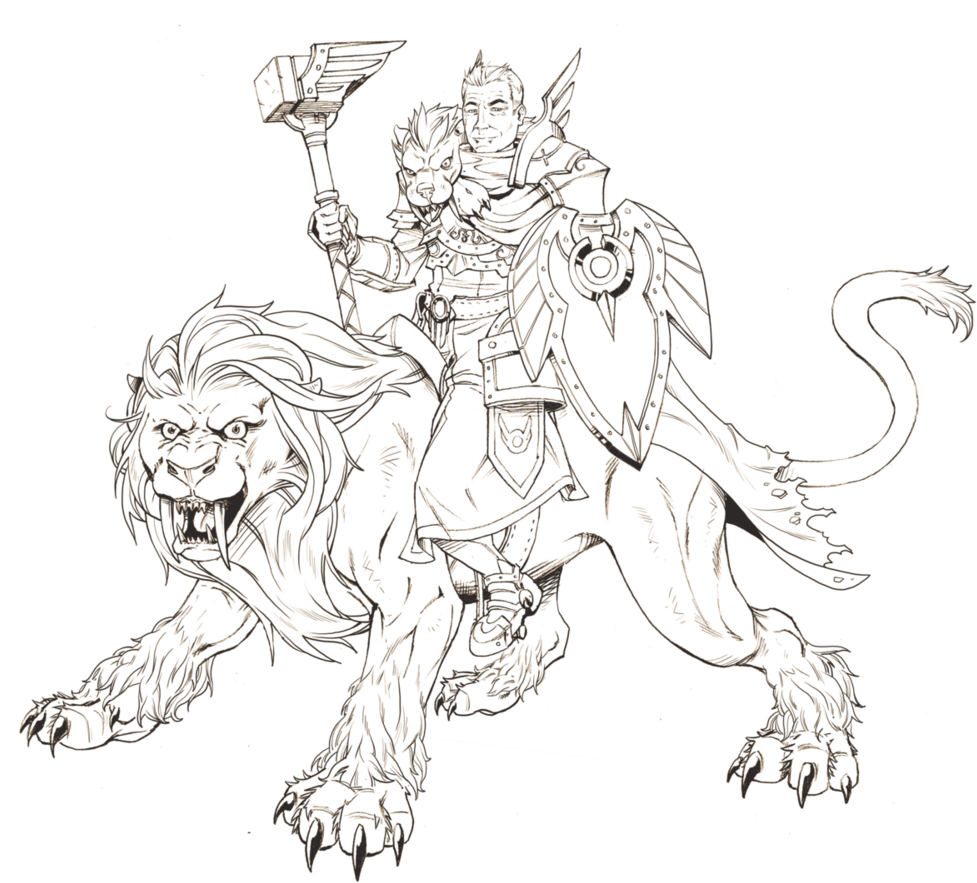
The Young Kingdoms
Upon the Ardovikian plain, new nations are being born. From the Dragon’s Teeth in the south to the edge of the Mammoth Steppes, hundreds of small kingdoms, independent townsteads, isolated keeps and fortified manses have been established, each one alternately warring and allying with its neighbours. The majority are ruled by Men, although there are realms of all kinds to be found, from Dwarfs and Elves to even – it is whispered – Vampires.
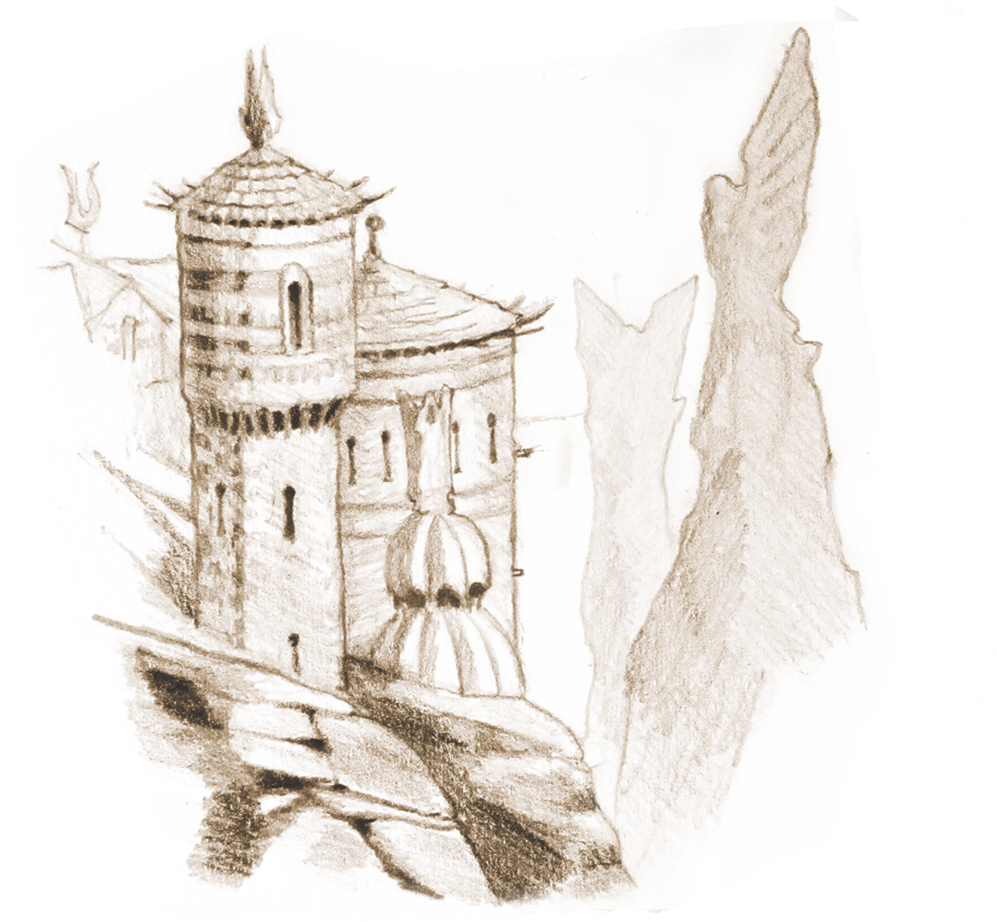
After nine centuries, some are only now showing promise, absorbing others through treaty or conflict, and becoming players on the grander stage. Cruel tyrants, idealistic nobles, religious zealots, chancers, pauper-kings, outcast knights, sorcerers and mercenaries – many and more have attempted to carve out a kingdom here, by the strength of their steel or the depths of their cunning. Some few have been so successful that they even now look beyond the Young Kingdoms, dreaming of the day that they may conquer those lands and march across the Dragon’s Teeth to Primovantor at the head of an unstoppable army.
The wise see the powers of the future taking root upon the Ardovikian flatlands, yet for now it remains a rough land, full of promise and danger. To be a king here is hard, but then again, here anyone can become a king.
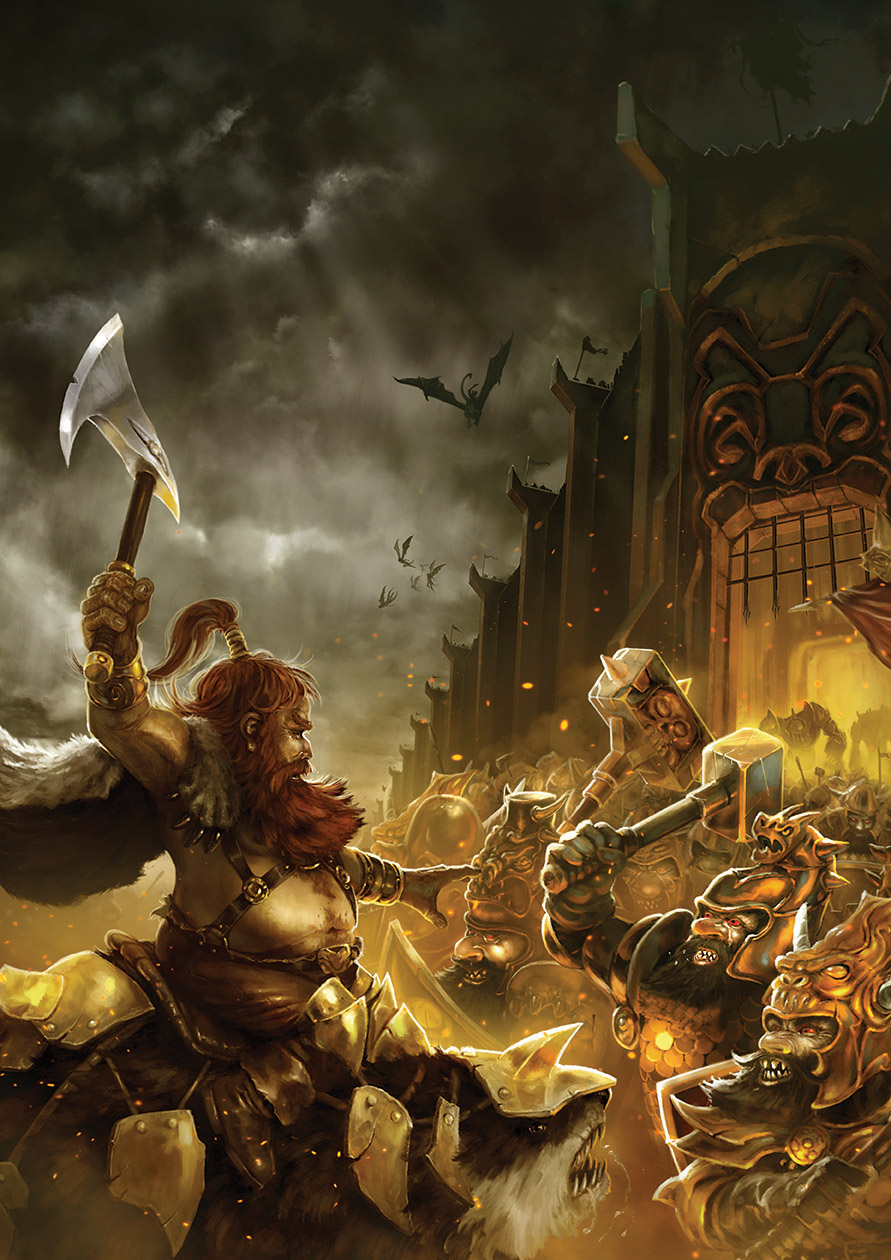
Ophidia
Ancient Ophidia, the most venerable of all man’s realms, has weathered catastrophe and war implacably. Long the rival of Primovantor, it has survived from the ancient time of light until today. For more than ten thousand years the God-Kings have watched over their subjects, who toil as they ever have on the perilously thin green strip of fertile land adjoining the River Ophid.
Ophidia is a harsh land, of ritual and cruelty, but also of beauty and opportunity, of gold and mystery. Its nobility are sorcerers, demonologists and even necromancers, though many whisper that its true masters are anything but human. It is a place where adventurers can find their fortune, braving serpent-haunted tombs and ancient ruins. Assassins lurk in every shadow, alchemists ply their trade in vast painted markets, and women of enviable beauty dance the long nights away to the hypnotic sound of drums. In crumbling temples and golden towers, the cult of the Magi make pacts with demonic Djinn in exchange for wealth and near-immortality. From this source, the Magi draw magical powers the envy of other realms of Men, but they do so at a cost to their souls that few would be willing to pay. It is only the wisdom of the Elven Southern Kindreds that allows the Magi to tread the fine line between arcane mastery and damnation, and this pact between Men and Elves is a rare thing in these troubled times.
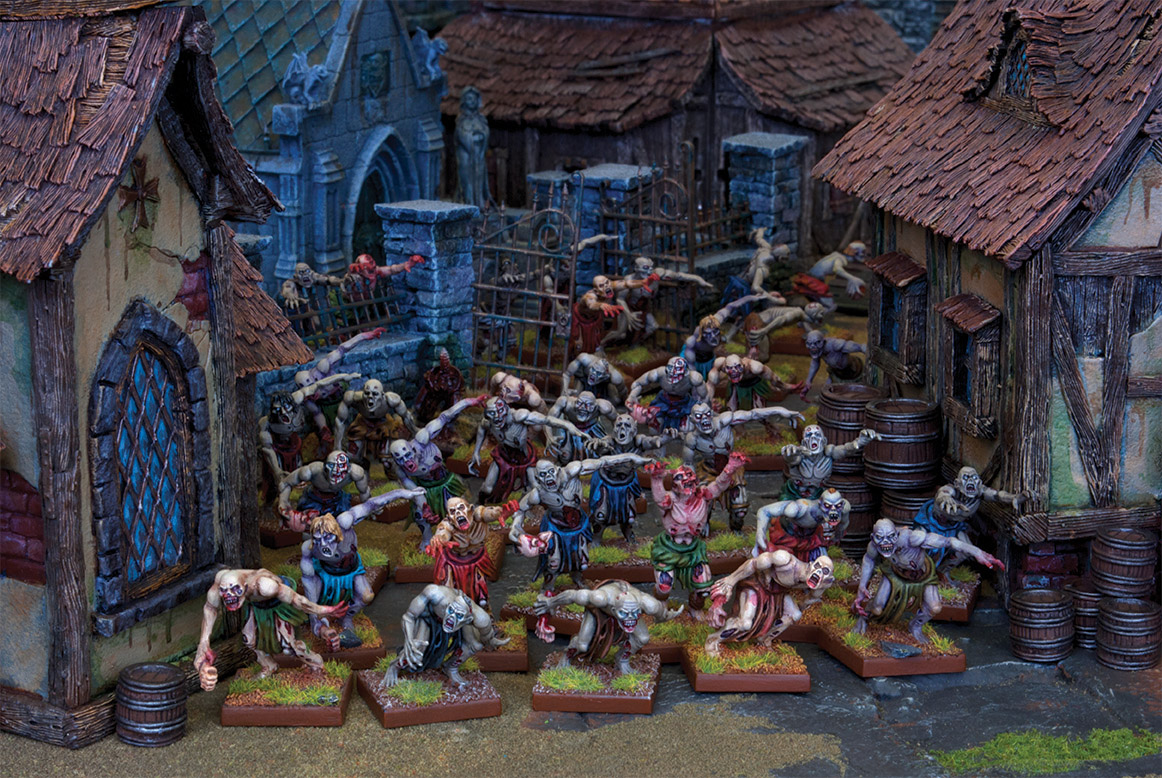
It is a hard truth that much evil in the world has come from Ophidia: the necromantic art of death magic, unbound Abyssals and those terrible perversions of humanity: the vampires and the ghouls, ghastly by-products of the Ophidian Sorcerers’ never-ending quest for immortality. This is a land where desert-borne spirits are enslaved to raise the monuments of the God-Kings, where elaborate funerary rituals are essential to prevent the return of the dead, where proud warriors fight alongside their reanimated fallen ancestors, and where, at the heart of it all, the true, cold-blooded Ophidians plot and scheme from their glittering towers.